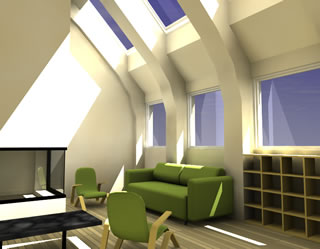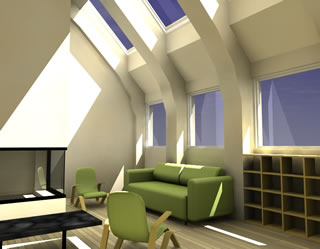Specular Effects With Final Gather
Diffuse illumination describes light that hits a surface and is reflected equally strong in all directions. A surface, which only has diffuse reflection appears matte and dull. Roughly sanded wood, or a flat wall paint are examples of materials with a high degree of diffuse reflection. Specular illumination describes light, that is reflected off a surface in about the same angle as the incident (or incoming) angle. On a curved surface, only those light rays, that are reflected off the surface and are hitting the eye point can be seen. Surfaces with specular reflection appear shiny, showing typical hot spots. A polished plastic or a glossy varnish paint are examples of materials with high specular reflection. Some materials have traits of both. For example smooth leather has some diffuse and some specular reflection.

Figure 1.6.16: The Calculate Specular Final Gather option in the
Plastic Option dialog.
Final gather presents three options in the Specular Illumination menu, which determine how specular effects are handled.
Direct Without Dome Lights: When this item is selected, specular effects are only created though direct illumination. This is the same as in a rendering not based on final gather. For example, a cone light shining on a glossy sphere will produce a bright hot spot. In addition, the specular effects of dome lights are not computed. For most architectural scenes, the highly non uniform light emitted by atmospheric or environment lights creates nice diffuse illumination, but little or no specular effects on flat surfaces. For example, a shiny floor won’t show any specular effects from dome lights. Thus, one might as well save the time computing them.
Direct With Dome Lights: When this item is selected, the specular effects are calculated as with the first option, except that dome lights now are included in the calculation of specular effect form direct illumination. This option is useful, if a scene consists of objects with curved surfaces, that produce specular highlights, such as the rendering of the dune buggy shown in Figure 1.6.12. Using this option will cause the rendering to be slower.
Indirect From Final Gather: With the first two options, a rendering shows only indirect diffuse illumination and direct specular illumination. When this option is selected, specular effects are calculated from all light sources though direct and indirect illumination. It is most useful to a create subtle shine on glossy surfaces, such as furniture in an architectural rendering.
The reflection shader of each material, that has a Specular Reflection parameter also has a check box called Calculate Specular Final Gather, as shown in Figure 1.6.16. This check box also needs be turned on for the Indirect From Final Gather option to work. By default, the Brushed, Simple Metal, Plastic, and Woven Reflection shader have this option turned on, whereas all others have it turned off.
Calculating specular indirect illumination in final gather is a time consuming process. It is therefore recommended to only compute specular indirect illumination for those objects in a scene, where this effect is noticeable and visually desirable. Highly reflective or transparent materials, such as a mirror or window glass will not benefit from the effect. Nevertheless it would be calculated, unnecessarily slowing down a final gather rendering, if this option were selected in the respective reflection shader.
a 
b 
Figure 1.6.17: An interior scene rendered (a) without and
(b) with Indirect Specular Illumination.
Note the subtle gloss on the chairs and couch.
Therefore, the ray trace based reflection shaders, such as Glass, Accurate Glass, Mirror or Paint have the Calculate Specular Final Gather option turned off by default. A good use for this option would be to assign a material with the Plastic shader and the Calculate Specular Final Gather option enabled to a sofa object that shows a leather like material. Only when this object is rendered will final gather spend the extra time to compute the specular effect. For the glossy floor, the Glossy reflection shader is used. It has the Calculate Specular Final Gather option turned off. Since the specular effect is not necessary for the floor, the rendering won’t be slowed down. A final gather rendering without and with specular indirect illumination are shown in Figure 1.6.17 (a) and (b).
To compute specular indirect illumination, final gather sends a number of rays from the pixel into the scene. The rays will intersect other surfaces and final gather calculates the illumination at each intersection. From the total illumination at all intersections, the specular effect is generated. The rays cast from the pixel are not uniformly distributed, but are focused around the direction of the reflected view vector. When using the preset Quality, the number of rays is set automatically. When editing the final gather parameters manually, the # Of Rays field is shown below the Specular Illumination menu, as shown in Figure 1.6.18. A reasonable range for this parameter is 10 to 400. Note that very smooth and shiny surfaces require a higher number of rays than rough surfaces.